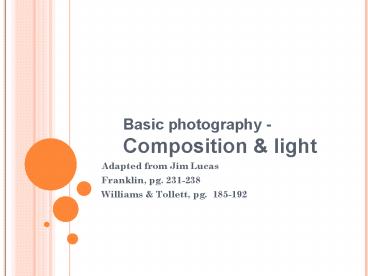Basic photography - Composition PowerPoint PPT Presentation
Title: Basic photography - Composition
1
Basic photography - Composition light
- Adapted from Jim Lucas
- Franklin, pg. 231-238
- Williams Tollett, pg. 185-192
2
Photographs
- Visualize role in design and message
- Survey different sources
- Adjust or remove features to complement purpose
- Choose simple, yet interesting composition
- Select lighting that enhances subject or
reinforces the message - Choose angle that best shows subject and
reinforces the purpose - Use color when practical
- Establish size, scale and orientation
3
(No Transcript)
4
Keep it simple
- Keep background uncluttered
- Avoid mergers
- Have single dominant subject
5
Single dominant subject
6
Cluttered background
7
Avoid mergers
8
(No Transcript)
9
Angle
- Low angle
- Clear sky backdrop
- Accentuate movement or action
- High angle
- Eliminate cloudy sky
- Avoid centered horizons
- Use the light
- Emphasize a point, tone
10
Angle
11
Strong center of interest
- Take pictures at different angles with different
compositions - Work around the rule of thirds
12
Rule of Thirds
13
Rule of Thirds
14
Balance
- Balance color and weight in a picture
- Formal and informal
- Symmetrical and asymmetrical
15
(No Transcript)
16
(No Transcript)
17
Line
- Line leads the eye
- Diagonals
- S-curves
- Static vs. dynamic lines
- Shape
18
Line
19
Line
20
Line
21
Framing
- Adds depth
- Should fit theme
- Watch focus on foreground
- Focus on foreground in landscape
- Focus on subject in portraits
- Auto-focus should be centered on main topic
- OverallDepends on camera
22
Framing
23
Framing
24
Fill the frame
- Would this picture look better if I was closer?
- Focus on subject
- Detail
- Start far and move closer
- Fill the frame with objects that fit
- Long range shots provide depth and perspective
25
Fill the frame
26
Fill the frame
27
Pick a good light direction
- Three light directions
- Front - sunny with high color
- Side - depth and texture
- Back - dynamic but challenging silhouettes and
water effects
28
Light Direction?
29
Light Direction?
30
Contrast
- Hard vs. soft light
- Sunny days high contrast (hard light)
- Cloudy days low contrast (soft light)
- Portraits often use soft light (shaded area)
- Flash will reduce contrast
- Soft light helps with color variations
- Time of day
31
Light and contrast
32
Light and contrast
33
Time of day
34
Light type
35
Action shot tips
- High shutter speed
- Telephoto lens
- Longer lens means faster shutter speed
- Stopping motion
- Far is easier than near
- Straight is easier than diagonal
- Diagonal is easier than right angles
- Panning
36
Action shots
37
Landscape tips
- Take pictures at the start and end of the day
- Anticipate weather changes
- Diffused light can highlight patterns and
textures - Bright light highlights monochrome colors
- Move around to exclude or block objects from view
38
(No Transcript)
39
Objects in the landscape tips
- Add scale, depth and focal points
- Use items to add interest to common or simple
scenes
40
(No Transcript)
41
Sunset tips
- Include shadowed image for interest
- Often best after the sun has actually gone down
- Less time closer to the equator to take
42
(No Transcript)
43
Wildlife tips
- Fill the frame
- Avoid barriers
- Shoot against the glass if in a car (no flash)
- Use tripod
- Blur background, or find simple one
- Focus on the eyes
- Go for natural poses, growls, yawns, etc.
44
(No Transcript)
45
Garden tips
- Strong diffused light is generally
bestespecially for single blooms - Macro lens
- Can help you get a 11 ration
- Avoid shadowing your subject
- Have smaller aperture to allow more depth of
field - Without macro 4 foot minimum
46
(No Transcript)
47
Take-away tips
- Think
- Experiment
- Move
- Wait
- Rule of Thirds

